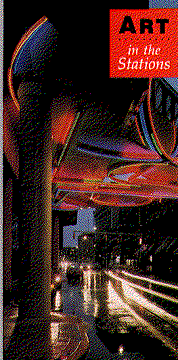Detroit Downtown Peoplemover
The Detroit downtown peoplemover opened shortly after the Miami Metromover .It has been in operation since July, 1987 over a 2.9 mile (4.67 km) loop that includes 13 passenger stations. Two of these stations are integrated into buildings (Millender Center and Cobo Hall). The fare is 50 cents for the general public, 25 cents for the disabled and free for the elderly. Data from the first year of operation showed a reliability of 98 percent with an average patronage of 11,000 per day (Aiken and Barker, 1989). The peak-day ridership during the first year was 54,648.
According to a recent paper (Tadi and Dutta, 1997) ridership is currently around 5,000 per day.
Several forecasts of ridership have been prepared for this system by different analysts at different times using different assumptions. They produced results that ranged from 16,000 to 93,000 per day in 1990. A comparison of these forecasting efforts and a description of their essential differences is presented in a published paper (Tadi, Dutta and Bondada, 1989). The larger forecasts were derived using an assumption that the peoplemover would be the final link in a multibillion dollar regional transit system that would have four subway lines, two region commuter rail lines and greatly improved bus service serving downtown. And, the downtown employment was assumed to increase by about 60 percent by the time the Mover was to open. These transit investments and downtown growth have not occurred. The later forecasts did not use these assumptions and produced a 1990 ridership estimate of 15,900 which bears a more reasonable relationship to the actual 1992 ridership figure of 10,000 per day. It takes approximately 14 minutes to travel the entire loop and the wait between trains averages 2-3 minutes. All cars and stations are fully accessible to the disabled.
Both the Miami and Detroit circulators have utilized relatively large capacity and expensive automated technologies that are quite costly to build, operate, maintain and extend. Both have operated reliably from a technical point of view. It may be argued that the Miami Mover will eventually be utilized more fully and be regarded as an essential service in the downtown area. The outlook for the Detroit Mover is now more hopeful that it has been for some time. General Motors is relocating it's headquarters to downtown Detroit in 1997 and this move should help to increase ridership on the Mover. Expansion of the system to the proposed new Tiger stadium (baseball) and a stadium for the Detroit Lions (football) in the downtown area would also help increase ridership.

One aspect of the Detroit system that is especially worthy of note is the art work that is part of every station. Each station is different and some people ride the system just to see the art. This photo shows some neon artwork that makes one of the Mover stations unique. The Downtown Detroit Peoplemover Art Commission (also called Art in the Stations) was created to incorporate major works of art into the thirteen stations. Fifteen artists (9 from Michigan) were selected to bring their designs to life in the stations. Most involve the use of tile, mosaic and other durable materials.
For more details and current infomation, see the unofficial but very good Detroit Peoplemover website
J. Bell's Detroit Mover website also provides additional detail
References:
Aiken, R.J. and T.C. Barker, 1989, Detroit Peoplemover Implementation: Year One, in Proceedings, Automated Peoplemovers II, edited by Bondada, Sproule and Neumann, American Society of Civil Engineers, New York, NY, 389-398.
Tadi, R.R., U. Dutta and M.V.A. Bondada, 1989, Prediction and Reality of Ridership for the DPM in Detroit, Michigan, in Proceedings, Automated Peoplemovers II, edited by Bondada, Sproule and Neumann, American Society of Civil Engineers, New York, NY, 2-10.
Tadi, R. and Utpal Dutta, 1997, Detroit Downtown People Mover: Ten Years After, paper presented at the 6th International Conference on Automated People Movers, Las Vegas, NV, April, 1997. It is available from ASCE or through interlibrary loan (in some cases).
Contact Information: Detroit Transportation Corporation, Julian Transportation Corporation, 1420 Washington Blvd., Detroit, Michigan, 48226; Phone: 313-963-0171 (Peoplemover Operations); 313-224-2160 (General Number)
Last modified: December 23, 2014